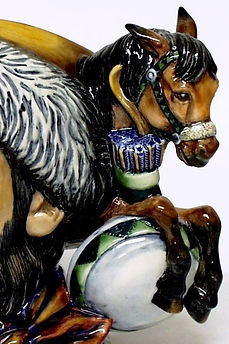
Attila the Hun character jug designed by Caroline Dadd and modeled by Robert I. Tabbenor, and produced by Royal Doulton of Burslem, England, in a 2005 limited edition of 250 for UK International Ceramics. Attila the Hun (circa 406-453) was king of the Huns and one of the most feared and notorious barbarians of all time. Believed to have been of distant Mongol stock, he was a striking figure with a large head, swarthy complexion, deep-seated eyes, thin beard, and a short, square body of a disproportioned form. He delighted in war. He and his Huns were known as the “Scourge of God,” being possibly the most destructive people in history. They originally came from Central Asia and in about 200 B.C. overran the Chinese Empire. Chinese emperor Shih Huang-ti built the massive Great Wall of China to keep out the Huns. Attila ravaged much of the European continent during the fifth century. After causing widespread devastation in Gaul, Attila invaded the Rhine with a large army of Huns and allied barbarian tribes, reportedly numbering between 300,000 and 700,000 men. Some of the greatest cities of Europe were sacked and put to the torch including Rheims, Mainz, Strasbourg, Cologne, Worms and Trier. Attila died an appropriately barbaric death, drowned in his own nosebleed the morning after a night of boisterous feasting on his wedding night. The empire of the Huns dissipated nearly as quickly as its most famous leader. A horse and shield form the handle of the jug. A colorway with a black horse is known.
Maker:
Royal Doulton
England
2005
Model #:
D7225
Great Military Leaders Series
character jug
Size:
large
Height:
6 1/2"




